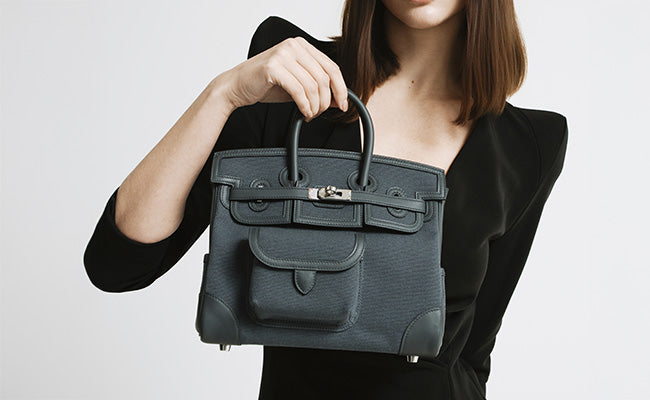
Photographing for Insurance & Auth: Angles, Metadata, and Storage
Check out our Hermès collection and Birkin bags!
If you’ve got an Hermès bag worth more than most cars, documenting it properly isn’t just a good idea. It’s essential.
And no, snapping a quick phone pic won’t cut it. Insurance and authentication photos need specific angles, solid metadata, and secure storage to really protect your investment and your claim.
The line between a photo that holds up in court and one that gets your claim tossed is thinner than you’d think. Insurance folks dig into everything from timestamps to GPS data, while authenticators want sharp, detailed shots that show off every stitch and bit of hardware.
Plenty of collectors have lost out just because their documentation didn’t meet professional standards. Whether you’re shooting a vintage Kelly for insurance or a brand-new Birkin for proof, you really want to get this right.
Key Takeaways
- Insurance photos need multiple angles, something for scale, and real, unedited metadata if you want your claim to stick
- Back up your photos securely and keep the metadata intact, otherwise, you risk losing your evidence or having it tampered with
- Following pro documentation standards can be the difference between a payout and a denial
Capturing the Right Angles for Insurance and Authentication
Choosing the right angles turns basic snapshots into documentation that insurance and authentication services will actually trust. Each photo should highlight key details and keep things consistent across your collection.
Essential Shots for Documentation
Front-facing shots show off the bag’s main features and condition. Set your Hermès against a plain background with soft, even light. This way you’ll get the silhouette, hardware, and any logos clearly.
Profile views (both left and right) let you capture depth and structure. You’ll see edge wear and how well the leather’s holding up.
Back panel shots are easy to forget, but they’re crucial. Lots of bags have unique stitching or hardware on the back that counterfeiters often miss.
Interior shots need careful lighting. Open everything up and get the lining, pockets, and stamped markings. Date codes or serial numbers usually live inside the bag.
Base photos show the bottom and any feet. These reveal wear from use and confirm construction details that support your insurance valuation.
Showcasing Luxury Details: Hardware, Stitching, and Materials
Macro shots bring out the stuff that matters for authentication. Get close-ups of locks, zippers, and buckles so you can see engravings and surface details.
Stitching photos need good lighting to show thread quality and patterns. Authentic bags have straight, even stitches, no loose threads or weird gaps.
Material close-ups highlight leather grain and texture. Natural light works best, especially for exotic leathers like crocodile or ostrich.
Hardware patina tells a story. Document aging on metal parts; insurance appraisers use this to check authenticity and condition.
Edge painting is another giveaway. Snap photos of the leather edges where the protective coating goes on, smooth and consistent is what you’re looking for.
Avoiding Common Mistakes in Luxury Bag Photography
Harsh shadows can hide important details and make your photos look amateurish. Use soft, diffused lighting to keep everything visible.
Cluttered backgrounds distract from the bag. Stick with plain, neutral backdrops for accurate color and easier authentication.
Blurry images are basically useless for claims. Make sure your camera’s focused, especially for close-ups.
Inconsistent lighting across photos makes it tough to judge color and condition. Try to keep your lighting the same for every shot.
No scale reference? Appraisers need context. Toss a ruler or coin in a few shots so the size is obvious.
Mastering Metadata: What, Why, and How
Metadata in your photos acts like a digital fingerprint. It can prove your claim or, if mishandled, undermine it. Knowing how to handle this hidden info protects your privacy and your investment.
Types of Metadata in Digital Photographs
Every digital photo has layers of metadata you can’t see at a glance. EXIF data logs camera settings, lens info, ISO, and timestamps.
GPS coordinates get added automatically unless you turn that off. Photographing your Hermès at home? You might be embedding your address right into the file.
Device info includes camera make, model, and sometimes serial numbers. Your iPhone leaves a different digital trail than a Canon DSLR.
| Metadata Type | Information Stored | Privacy Risk |
|---|---|---|
| EXIF | Camera settings, timestamp | Low |
| GPS | Precise location coordinates | High |
| Device Info | Make, model, serial number | Medium |
| User Data | Copyright, keywords, descriptions | Medium |
User-added metadata (keywords, descriptions, copyright) can be helpful for insurance, but you’ll want to think about what you include.
How Metadata Impacts Authentication
Insurance companies and authenticators rely on metadata to check your story. Timestamps help prove when you got the bag and when you took the photos.
Location data matters, too. If you say you bought a Birkin in Paris but the photo’s metadata says Toronto, that’s a problem.
Device patterns help show ongoing ownership. If all your photos come from the same phone or camera, that’s a good sign.
Sequential file names and timestamps show you took multiple photos in one session, which strengthens your claim.
But metadata isn’t foolproof. Some people know how to change or erase it, so it’s just one tool in the box.
Editing and Protecting Metadata
Remove metadata before sharing photos online or with third parties. While most editing apps strip some data, don’t count on it to do everything.
Selective preservation lets you keep what’s useful (like timestamps and camera info) while wiping sensitive stuff (like GPS or personal notes).
Popular metadata tools:
- Adobe Lightroom: Full-featured editing and metadata control
- ExifTool: For those who like command-line precision
- Photo Mechanic: Great for batch jobs
- Preview (on Mac): Basic viewing and editing
Backup your originals with full metadata in a separate spot from edited, stripped versions. You’ll want the unedited files for insurance, and the sanitized ones for sharing.
Batch processing is a lifesaver. Don’t edit each image one by one, clear metadata from whole folders at once.
Metadata and Surveillance Concerns
Law enforcement agencies may request access to metadata through legal channels in certain cases.
Tech companies (think Google) scan uploaded photos and pull out metadata. This info can end up with authorities via FISC warrants or other legal backdoors.
Cloud storage isn’t immune. When you upload to iCloud or Google Photos, those companies can access your metadata, even if you think your files are private.
Social media strips some metadata, but not always all of it. With the right know-how, people can sometimes recover what’s left.
Is the convenience of cloud backups worth the privacy risk? For high-value items, local storage and manual backups give you more control.
Legal protections change all the time and vary by country. What’s private now might not stay that way.
Storage Solutions: Preserving Your Photos Securely
When you’re documenting luxury items for insurance, how you store those photos is just as important as the photos themselves. You want reliable cloud options, solid backups, and the right file formats to keep everything safe and accessible.
Cloud Storage Options for Luxury Collectors
If you own high-value bags, losing your documentation isn’t an option. Adobe Creative Cloud works well if you’re already using Lightroom; $19.99/month for 20GB, and it’s seamless.
Google Photos gives you 15GB free and has handy AI search features. It’ll auto-tag your Birkin photos so you can find them fast.
For more security, NordLocker offers zero-knowledge encryption at $3.19/month for 500GB. Not even their staff can see your files.
Backblaze gives you unlimited backup at $9/month. It’s great if you’ve got a huge collection and want everything backed up automatically.
Mix and match for redundancy. Maybe keep your main set on Google Photos for easy access, and let Backblaze handle the full backup.
Offline and Backup Strategies
Cloud isn’t enough by itself. Stick to the 3-2-1 rule: three copies, two types of media, one offsite.
External hard drives give you direct control. Go for enterprise-grade models like Western Digital Black or Seagate IronWolf for better reliability.
NAS (Network Attached Storage) lets you run your own mini-cloud at home. Synology and QNAP are user-friendly and sync across devices, but your files stay on your network.
Set your backups to run automatically every week. Sync photos to the cloud right after taking them, then back up to external drives monthly.
Keep one backup offsite, maybe in a safety deposit box with your valuables.
File Formats and Compression Tips
RAW files capture all the details and metadata. Shoot in your camera’s native RAW format, CR3 for Canon, NEF for Nikon, etc.
TIFF files are great for archiving. Use LZW compression to shrink file size without losing anything important.
JPEGs are fine for sharing with your insurer, but don’t over-compress. Stick to 90% quality or higher so details aren’t lost.
Keep your original file names with dates and item descriptions. Something like "2025-09-29_Hermes-Birkin-35cm-SerialXYZ.CR3" makes life easier later.
Never delete your originals after editing. Store RAWs and processed versions in separate folders to keep your documentation chain solid.
Privacy and Security: Keeping Your Hermès Safe Online
When you’re photographing your Hermès for insurance, you’re not just protecting the bag, you’re protecting your own privacy. Digital photos leave invisible trails that can reveal way more than you’d like.
Risks of Geotagging and Device Metadata
Every photo you take on your phone or camera packs in metadata, GPS, timestamps, device info.
This data can pinpoint your address, daily habits, and even when you’re away from home with your collection. Criminals love this stuff.
High-end cameras in your metadata can also tip off thieves that you own other pricey gear.
Watch out for:
- GPS coordinates (your home or storage location)
- Timestamps (when you’re home or away)
- Device serial numbers
- Camera make and model
You can turn off location services in your camera app. Most editing software lets you strip metadata, too.
Don’t trust social media to remove everything. Do it yourself for peace of mind.
Controlling Access and Sharing Settings
Cloud storage like Google Photos brings its own privacy headaches. These platforms scan your images for faces and objects, building up a profile of what you own.
Check your:
- Sharing permissions
- Backup locations
- Third-party app access
- Album visibility
Keep insurance documentation in private, locked albums. Don’t share these folders unless you must. Use strong passwords and turn on two-factor authentication.
Encrypted storage is best for sensitive photos. Look for end-to-end encryption so even the platform can’t see your stuff.
Check your sharing settings every so often. Companies change their policies, sometimes without telling you.
Dealing With Surveillance and Third Parties
Government agencies can get access to your photos through various legal channels. The Patriot Act gave them broad powers to request data from tech companies, often without you knowing.
The NSA and others work under FISC court orders, and companies aren’t allowed to tell you if your data’s been accessed.
To protect yourself:
- Use a VPN when uploading
- Pick platforms based outside major surveillance countries
- Encrypt files before you upload
- Keep sensitive backups local, not in the cloud
You can also minimize your digital trail by not uploading every photo. For insurance, consider keeping documentation only on encrypted external drives.
Some insurers have secure portals for uploading documentation, these tend to be safer than consumer cloud services.
Keep an eye on privacy policies. They change, and not always in your favor.
Copyright and Ownership: Legal Considerations for Photos
When you photograph luxury items for insurance, copyright comes into play in a couple of ways: protecting your own photos and respecting other people’s intellectual property. In Canada, you get copyright protection for your photos the moment you take them, but if there’s copyrighted material in your shot, you’ll want to tread carefully.
Understanding Copyright for Your Images
We own the copyright to our insurance photos the instant we snap them. No need to register, but if a dispute pops up, registering with the Canadian Intellectual Property Office definitely helps our case.
Our copyright gives us a few important powers:
- Reproduction rights – deciding who can copy our images
- Distribution rights – controlling how photos get shared
- Public display rights – choosing where images show up
For insurance photography, we usually keep copyright and just grant clients specific usage rights. Having clear licensing agreements helps avoid ugly disputes down the line.
It's smart to add metadata, ownership info baked right into each image file. This digital fingerprint can back us up if someone uses our photos without asking.
Watermarking insurance photos works two ways: it warns off would-be thieves and keeps our branding visible. Just make sure watermarks don't block any key details that claims adjusters need to see.
Dealing With Copyrighted Materials in Shots
Luxury items often show off copyrighted designs, logos, and artwork that can complicate insurance photography. That rare Hermès scarf? Its pattern might be protected.
Fashion items are a special case. Designer bags, jewelry, and clothing usually have copyrighted elements. For insurance purposes, we’re generally safe under fair dealing, but it’s a fine line sometimes.
Artwork and collectibles need extra care. Snapping a painting or sculpture for insurance is usually fine, but using those photos elsewhere could cross a line.
Product packaging and branding aren’t much of a worry for insurance documentation. We’re just proving ownership, not making knockoffs.
If you’re not sure, stick to a documentary style that’s clearly for insurance, not art or ads. This approach gives us better fair dealing protection.
Navigating Copyright Regulations in Canada
Canadian copyright law treats all tech the same, film or digital, the rules don’t change. The 2012 Copyright Modernization Act only made these protections stronger.
Fair dealing exceptions give us a lot of leeway when shooting for insurance. This covers:
- Private study and research
- Criticism and review
- News reporting
- Parody and satire
Copyright lasts for the creator’s life plus 70 years. Most luxury items we shoot are fine, but vintage pieces with protected designs might need extra attention.
Model and property releases aren’t usually needed for insurance photos since we’re just documenting what we own. But if we’re shooting in rentals or people are in the shot, releases add a layer of safety.
Cross-border issues come up with high-value collections. International copyright treaties help, but enforcement isn’t always consistent.
Handling Auth Services and Insurance Claims
Authentication services dig into photo metadata and how we submit files, while insurance claims come with their own standards and privacy rules. Both demand we pay close attention to technical details and keep things secure.
What Authentication Services Look For
Authentication services check the metadata in our photos to verify authenticity. They look at timestamps, GPS data, camera settings, and device info to pin down when and where we took each shot.
EXIF data is key. It logs camera model, lens, ISO, exposure, basically, a digital fingerprint for each image.
Geotags confirm the location. Some luxury authentication services even match this data against known retailer or dealer spots.
If we tweak images, even just bumping brightness, file history shows it. Authentication algorithms can spot these edits.
Camera serial numbers in the metadata add another layer of proof. This helps separate genuine documentation from fakes.
Preparing Photos for Smooth Claims
Insurance claims go smoother if we organize and label photos before sending them off. Snap multiple angles of each damaged item: wide shots for context, close-ups for details.
Key documentation includes:
- Serial numbers for electronics and luxury goods
- Manufacturing labels and authenticity marks
- Damage from several angles
- Scale references (like a ruler or coin)
Keep date and time stamps accurate and untouched. Adjusters use this info to check our timeline and spot any oddities.
Shoot in good light to avoid blown-out or too-dark images. Clear, sharp photos keep the process moving.
Organize files by room or item type. Folders make it easier for adjusters to find what they need.
Protecting Sensitive Information in Submissions
Privacy matters when sharing photos that might include personal or location data. Always check the metadata before sending images to authentication services or insurance companies.
Metadata removal tools can strip out sensitive info without hurting image quality. Phones and cameras often include more location data than we realize, sometimes even home addresses.
Be picky about cloud storage. Only share with people who need access, and use encrypted platforms when possible.
If personal documents appear in the background, edit them out or retake the shot. Credit cards, IDs, or private mail can sneak into wide photos without us noticing.
Insurance companies may store submissions for years. It’s worth knowing their retention policies so we can decide what we’re okay with sharing long-term.
Frequently Asked Questions
Here are some common questions about documenting luxury items, from snapping designer pieces to keeping your photographic evidence safe and sound.
What's the prime angle to snap my Hermès bag to showcase its condition for insurance documentation?
We suggest shooting your Hermès bag from a few different angles to cover all the bases. Start with a straight-on front view against a plain background, making sure the hardware and leather grain are easy to see.
Next, try a three-quarter angle that shows both the front and side, this highlights the bag's shape and details like stitching and hardware.
Don't skip the bottom and interior. The bottom reveals wear, and interior shots show serial numbers, date stamps, and other authentication details insurers want.
How can I best capture the unique details of my luxury items in photos without losing the prestige?
We lean on macro photography to grab those fine details without making the item look less impressive. Natural light or soft LED panels help avoid harsh shadows and keep everything looking sharp.
Keep your camera at the same level as the item, not pointing down. That way, the piece keeps its presence and all the details stay crisp.
Context matters, too. Snap a shot of the item in a nice setting, a well-decorated room or elegant surface, to reinforce its premium status and help with documentation.
Darling, could you enlighten me about the ideal metadata tags I should use when archiving photos of my high-end collectibles?
We organize metadata into categories insurers care about: brand, model number, serial number, and purchase date go in the filename and EXIF data.
Add custom keywords like "authentication," "condition documentation," and the collection name. Geographic info should show storage location, and timestamps need to reflect the real documentation date.
If possible, embed appraisal values, receipt numbers, and authentication certificate details in the metadata. This makes a digital trail that insurers can follow easily.
For my peace of mind, what's the most secure way to store photographic evidence of my assets?
We’d go with a three-layer backup system for both safety and convenience. Keep originals on a local encrypted drive, then store copies in two different cloud services.
Pick cloud providers with end-to-end encryption and good reputations with insurance companies. Google Drive, Dropbox Business, and Microsoft OneDrive all have solid security and sharing features.
Give access to a trusted family member or legal rep, as your insurance docs specify. That way, your photos are available even if you’re out of the picture during a claim.
In the unfortunate event of a claim, what photographic proof do insurers adore for speedy validation of my treasures?
Insurers love before-and-after photos that clearly show the item’s condition before and after the loss. Time-stamped images with intact metadata help speed things up.
Serial numbers, authentication marks, and proof-of-purchase shots taken with the item create a strong chain of ownership. Scale references like a ruler or coin show the size accurately.
Multiple angles that reveal wear, usage, and any imperfections help establish the baseline condition. This can head off arguments over pre-existing versus claim-related damage.
Could you suggest the most discreet yet effective watermarking techniques for images of my valuable collection?
Honestly, subtle watermarks tend to work best. Just tuck them into corners or along the edges so they don't mess with the main details.
We usually go with semi-transparent text, maybe your name, the date, and some unique identifier for each piece. That way, it's there if you need it but doesn't scream for attention.
If you want something even less obvious, try invisible digital watermarks. Tools like Digimarc or even PhotoShop's built-in features let you embed these without messing up the image quality. They're surprisingly robust, sticking around even if someone crops or edits the photo.
For insurance or official records, metadata watermarking is another option. Instead of putting anything on the image itself, you just add ownership info to the file's metadata. It keeps the image looking clean, but professionals can still check the details when it matters.




